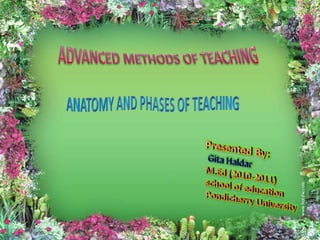Anatomy(structure) and phases of teaching
•Télécharger en tant que PPTX, PDF•
29 j'aime•24,361 vues
Anatomy(structure) and phases of teaching
Signaler
Partager
Signaler
Partager

Recommandé
Recommandé
Contenu connexe
Tendances
Tendances (20)
Knowledge base of teacher Education from view point of T.S. Schulman

Knowledge base of teacher Education from view point of T.S. Schulman
Personalized System of Instruction(PSI)Keller plan

Personalized System of Instruction(PSI)Keller plan
Unit 1 - C2 Understanding the social diversity-dr.c.thanavathi

Unit 1 - C2 Understanding the social diversity-dr.c.thanavathi
Ncfte- 2009 (National Curriculum Framework for Teacher Education)

Ncfte- 2009 (National Curriculum Framework for Teacher Education)
DISTRICT INSTITUTE FOR EDUCATION AND TRAINING (1987.pptx

DISTRICT INSTITUTE FOR EDUCATION AND TRAINING (1987.pptx
En vedette
En vedette (20)
The Teaching Learning Process: Intro, Phases, Definitions, Theories and Model...

The Teaching Learning Process: Intro, Phases, Definitions, Theories and Model...
Teacher's function, operation and activities in teaching 

Teacher's function, operation and activities in teaching
Principles of Teaching:Different Methods and Approaches

Principles of Teaching:Different Methods and Approaches
Methods and strategies of teaching by Jerrin Issac

Methods and strategies of teaching by Jerrin Issac
from a talk on trends in teacher and learner autonomy

from a talk on trends in teacher and learner autonomy
Similaire à Anatomy(structure) and phases of teaching
Similaire à Anatomy(structure) and phases of teaching (20)
GOAL OF SUPERVISION: IMPROVEMENT OF INSTRUCTION.ppt

GOAL OF SUPERVISION: IMPROVEMENT OF INSTRUCTION.ppt
Education and its relation with spiral curriculum.pptx

Education and its relation with spiral curriculum.pptx
Teaching Learning Process and Curriculum Development

Teaching Learning Process and Curriculum Development
Teaching learning process and curriculum development

Teaching learning process and curriculum development
Plus de School of eduction, PU
Plus de School of eduction, PU (20)
Styles, strategies and tactics approaches to teaching

Styles, strategies and tactics approaches to teaching
Teaching tactics - chain learning sructure and concept learning structure

Teaching tactics - chain learning sructure and concept learning structure
Dernier
Dernier (20)
Food Chain and Food Web (Ecosystem) EVS, B. Pharmacy 1st Year, Sem-II

Food Chain and Food Web (Ecosystem) EVS, B. Pharmacy 1st Year, Sem-II
Basic Civil Engineering first year Notes- Chapter 4 Building.pptx

Basic Civil Engineering first year Notes- Chapter 4 Building.pptx
Micro-Scholarship, What it is, How can it help me.pdf

Micro-Scholarship, What it is, How can it help me.pdf
Asian American Pacific Islander Month DDSD 2024.pptx

Asian American Pacific Islander Month DDSD 2024.pptx
Measures of Central Tendency: Mean, Median and Mode

Measures of Central Tendency: Mean, Median and Mode
Unit-IV; Professional Sales Representative (PSR).pptx

Unit-IV; Professional Sales Representative (PSR).pptx
Russian Escort Service in Delhi 11k Hotel Foreigner Russian Call Girls in Delhi

Russian Escort Service in Delhi 11k Hotel Foreigner Russian Call Girls in Delhi
Role Of Transgenic Animal In Target Validation-1.pptx

Role Of Transgenic Animal In Target Validation-1.pptx
Anatomy(structure) and phases of teaching
- 1. ADVANCED METHODS OF TEACHING ANATOMY AND PHASES OF TEACHING Presented By: Gita Haldar M.Ed (2010-2011) school of education Pondicherry University
- 2. Introduction Teaching is an important part of the process of education. Its special function is to impart knowledge, develop understanding and skill. Teaching is usually associated with 3 R’s i.e. Reading, writing and arithmetic imparting knowledge of school subjects. Definitions of teaching “The art of assisting another to learn providing of information and of appropriate situations, conditions or activities designed to facilitate learning.”
- 3. According to world book encyclopedia- “The process by which one person helps other achieves knowledge, skill and aptitudes.” According to John B. Hugh: Teaching is an activity with four phases: a curriculum planning phase, an instructing phase, a measuring phase and an evaluate phase.
- 4. ANATOMY /STRUCTURE OF TEACHING: THREE VARIABLES Structure of teaching consists of three variables which operate in the process of teaching and create learning conditions or situations. These are classified as under: Teacher as an independent variable. Students as dependent variable. Content and strategy of presentation as intervening variables.
- 6. 1. Teacher as an independent variable The teacher plans the role of independent variables. Students are dependent on him in the teaching process. The teacher does the planning, organizing, leading and controlling of teaching for bringing about behavioral changes in the students. He is free to perform various activities for providing learning experiences to students.
- 9. We can divide the teaching act into three phases of teaching as shown below:
- 10. Pre – active phase of teaching Fixation of goals. Decision making about the subject matter. Arranging/ sequencing the elements of content for presentation. Decision about the strategies of teaching. Distribution of teaching strategies.
- 11. INTERACTIVE PHASE OF TEACHINGAccording to the P.W. Jackson “The teacher provides pupil verbal stimulation of various kinds, makes explanations, ask questions, listen to the student’s response and provide guidance”. The following activities are included in the inter-active phase of teaching- 1. Sizing up of the class. 2. Diagnosis of the learners. Abilities of learners. Interests and attitudes of learners. Academic background of learners. 3. Action and reaction of achievement. Initiation, Response.
- 12. Post-active phase of teaching:In this phase, as the teaching task sums up, the teacher asks the questions from the pupils, verbally or in written form, to measure the behaviors’ of the pupils so that their achievements may be evaluated correctly. Defining the exact dimensions of the changes caused by teaching. Selecting appropriate testing devices and techniques. Changing the strategies in terms of evidences gathered.
- 13. Conclusion: It is evident from the above description that to achieve the teaching objectives, ‘the three aspects of teaching activities should be arranged in such a way that when the changes occur in the thinking and working systems of pupils, creative thinking should also be developed in them so that, by recognizing reality, they may become efficient in co-ordination their external experiences with their inner organization.
- 14. THANK YOU
